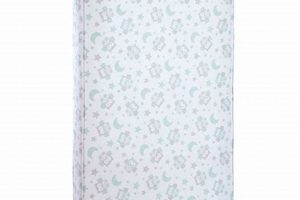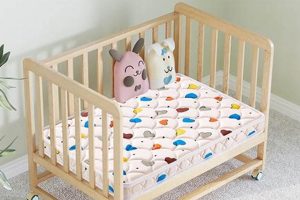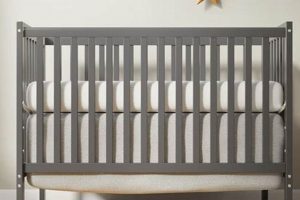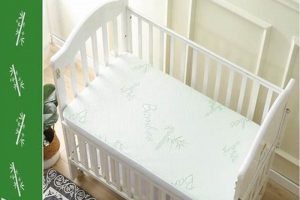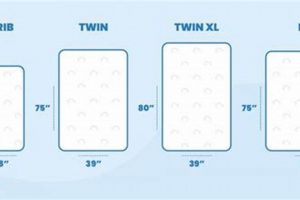The dimensions of bedding for infants and toddlers differ significantly from those designed for older children. Infant beds utilize smaller mattresses to ensure safety and accommodate the limited space requirements of a nursery. Conversely, beds intended for older children are larger, providing increased space and comfort as they grow. A typical example of the smaller type measures approximately 28 inches wide by 52 inches long, while the larger commonly measures around 38 inches wide by 75 inches long.
Understanding the distinction in bedding dimensions is crucial for ensuring appropriate fit and safety. Selecting the correct size mattress prevents potential hazards such as gaps between the mattress and bed frame, which could pose a risk of entrapment. Historically, these size differences have evolved based on research into infant and child safety, as well as ergonomic considerations for promoting healthy sleep and development.
The following sections will delve into specific measurements, intended age ranges, safety considerations, and purchasing advice related to different mattress dimensions. This information will provide a detailed comparison to help consumers make informed decisions.
Important Considerations for Mattress Dimensions
Selecting the appropriate mattress requires careful consideration of several factors to ensure safety and comfort. The following guidelines provide essential information for making informed decisions regarding mattress size.
Tip 1: Verify Internal Bed Frame Dimensions: Before purchasing any mattress, measure the internal dimensions of the bed frame. Ensuring that the mattress fits snugly within the frame is paramount for safety, preventing gaps where a child could become trapped.
Tip 2: Prioritize Firmness for Infants: For infants, firmness is critical. A firm mattress reduces the risk of Sudden Infant Death Syndrome (SIDS) by providing a stable surface. Soft mattresses can conform to the infant’s face, posing a suffocation hazard.
Tip 3: Consider Material Composition: Investigate the materials used in mattress construction. Opt for mattresses made from non-toxic materials, free from harmful chemicals such as phthalates and formaldehyde. Certifications like GREENGUARD Gold indicate adherence to strict chemical emission standards.
Tip 4: Evaluate Mattress Thickness: Mattress thickness should be appropriate for the bed frame. Excessively thick mattresses may compromise safety by reducing the height of guardrails, while overly thin mattresses may not provide adequate support.
Tip 5: Account for Growth Spurts: When transitioning to a larger mattress, consider the child’s anticipated growth. Selecting a larger mattress that can accommodate future growth spurts can provide longer-term value and comfort.
Tip 6: Inspect for Durability: Examine the mattress construction for signs of durability. Reinforced edges and sturdy stitching can enhance longevity, particularly with active children.
Tip 7: Follow Manufacturer Guidelines: Adhere to the manufacturer’s recommendations regarding mattress usage, cleaning, and maintenance. These guidelines ensure proper care and maximize the lifespan of the product.
Adhering to these guidelines enhances the safety and suitability of the selected mattress, providing a secure and comfortable sleep environment for children.
The subsequent section will present information about finding and understanding the best mattress based on consumers needs.
1. Intended Use
The correlation between intended use and mattress dimensions is fundamental. The primary objective dictates size selection. Infant use mandates compact dimensions for safety and nursery space optimization. Conversely, usage by older children necessitates larger dimensions to accommodate growth and provide adequate comfort. A mismatch can compromise safety and sleep quality.
Consider the scenario of an infant placed on a twin-size mattress. The increased space surrounding the infant poses a safety hazard due to the potential for entrapment. Conversely, confining an older child to a smaller mattress restricts movement and impairs sleep. The selection of one versus the other must align with the child’s developmental stage and physical stature. A toddler bed, a transitional option, represents a middle ground, but ultimately leads to the need for the latter solution.
Therefore, intended use acts as the initial determinant when choosing bedding. Incorrect dimension selection creates safety risks and impacts sleep quality. Understanding this relationship is paramount for informed decisions and promoting healthy sleep environments for children of all ages. This leads to more research on what should be the perfect size.
2. Dimensional Variance
Dimensional variance constitutes a primary differentiator. The standard infant mattress typically measures around 28 inches in width and 52 inches in length, whereas the common dimensions for a twin mattress are approximately 38 inches wide by 75 inches long. This size disparity is not arbitrary; it directly correlates with the physical needs and safety requirements of differing age groups. The smaller dimensions promote a secure environment for infants, mitigating the risk of entrapment and suffocation. The larger dimensions of the twin mattress accommodate the growth and movement of older children, facilitating comfortable and unrestricted sleep.
An inadequate understanding of dimensional variance can lead to suboptimal purchasing decisions. For example, attempting to utilize infant bedding within a twin-sized frame creates hazardous gaps, compromising safety. Conversely, forcing an older child to sleep on the infant mattress restricts movement, disrupting sleep patterns and potentially affecting physical development. Proper dimensional alignment ensures that the bedding complements the occupant’s physical attributes, promoting healthy sleep habits and minimizing potential hazards. Regulatory standards, such as those established by the Consumer Product Safety Commission (CPSC), further reinforce the importance of adhering to specified dimensions to ensure safety compliance.
In summary, dimensional variance is not merely a matter of size; it is an integral component of child safety and sleep quality. Recognizing and respecting these dimensional distinctions allows consumers to make informed choices that align with developmental needs and safety protocols. Failing to consider these variances can have detrimental effects on a child’s well-being. The information provided in the next section will explain how to properly determine safety standards.
3. Safety Standards
Adherence to established guidelines constitutes a critical aspect when evaluating bedding options for infants and children. These standards are designed to minimize risks and ensure the well-being of the user, with mattress dimensions being a central consideration.
- Flammability Regulations
Mattresses must comply with federal flammability standards, primarily 16 CFR Part 1632 and 16 CFR Part 1633. These regulations dictate the mattress’s ability to resist ignition from open flames. Non-compliant bedding poses a significant fire hazard. For example, a mattress failing to meet these standards could ignite rapidly, increasing the risk of injury or fatality. The proper dimensions ensure the mattress fits securely within the bed frame, further minimizing potential hazards.
- Material Composition
Safety standards dictate the types of materials permissible in mattress construction. Regulations often restrict the use of certain chemicals, such as phthalates, lead, and formaldehyde, due to their potential toxicity. Mattresses with appropriate dimensions are often tested to ensure they do not emit harmful volatile organic compounds (VOCs), which can affect air quality and respiratory health. Selecting a mattress made from certified non-toxic materials is crucial for minimizing exposure to hazardous substances. For instance, GREENGUARD Gold certification indicates that a mattress has been tested for chemical emissions and meets strict standards.
- Size and Fit Requirements
The Consumer Product Safety Commission (CPSC) sets specific size and fit requirements to prevent entrapment hazards. A properly sized mattress should fit snugly within the bed frame, leaving minimal gaps. Excessive space between the mattress and the frame can pose a risk of a child becoming trapped. The CPSC mandates that infant mattresses adhere to specific dimensional standards to mitigate this risk. Regularly inspecting the fit of the mattress ensures ongoing compliance with safety regulations and reduces the likelihood of accidents.
- Firmness and Support
Standards emphasize the importance of mattress firmness, particularly for infants. A firm surface reduces the risk of Sudden Infant Death Syndrome (SIDS) by preventing the infant from sinking into the mattress and potentially obstructing their airway. Softer mattresses can conform to the infant’s face, posing a suffocation hazard. Regulations may specify minimum firmness levels to ensure adequate support and safety. Choosing a mattress that meets these firmness requirements is paramount for promoting safe sleep practices.
In summation, safety standards related to mattress dimensions are multifaceted, encompassing flammability, material composition, size and fit, and firmness. Adhering to these regulations is essential for creating a safe sleep environment, mitigating potential hazards, and promoting the well-being of infants and children. Consumers should diligently verify that bedding meets established standards before making a purchase, prioritizing safety above all other considerations.
4. Room Size
Room size exerts a direct influence on the selection of appropriate bedding dimensions. The physical space available dictates whether a larger mattress, designed for older children, can be accommodated, or if a smaller mattress is more suitable. Effective space planning is paramount to ensuring both functionality and safety within the room.
- Spatial Constraints
Limited room dimensions may preclude the use of a twin mattress, necessitating the selection of a smaller infant or toddler mattress. Overcrowding a room with an oversized mattress can impede movement, creating potential safety hazards. Navigating the room becomes difficult, increasing the risk of accidents. Conversely, a spacious room may easily accommodate a twin mattress, providing ample space for play and other activities. The physical constraints of the room thus become a primary determinant in bedding selection.
- Furniture Arrangement
The arrangement of other furniture within the room impacts mattress selection. A room containing a crib, dresser, and changing table may lack the necessary space for a twin mattress. Strategic furniture placement can optimize space utilization. Selecting multifunctional furniture, such as a crib that converts into a toddler bed, can also alleviate spatial constraints. The overall furniture arrangement must be considered to ensure the selected mattress dimensions harmonize with the room’s layout.
- Aesthetic Considerations
Room size influences aesthetic choices. A large mattress can dominate a small room, creating a visually unbalanced appearance. Selecting a smaller mattress can enhance the room’s overall aesthetic appeal. The choice of bedding should complement the room’s design and color scheme. Aesthetic considerations, while secondary to safety and functionality, contribute to the overall ambiance of the room. A well-proportioned mattress enhances the room’s visual appeal.
- Future Adaptability
Anticipating future needs informs mattress selection. A room that may currently accommodate a crib may need to adapt to a twin mattress as the child grows. Planning for future adaptability ensures the room remains functional and aesthetically pleasing. Selecting versatile furniture and considering the room’s potential for expansion can facilitate a smooth transition. A room’s adaptability should be considered when making initial bedding choices.
In conclusion, room size is a crucial factor influencing the dimensions of bedding. Spatial constraints, furniture arrangement, aesthetic considerations, and future adaptability all contribute to informed decision-making. A comprehensive understanding of these factors promotes safe, functional, and aesthetically pleasing sleep environments. These elements also contribute to how suitable is a mattress for a specific age.
5. Age Suitability
Age suitability functions as a primary determinant in the selection between infant and twin mattress dimensions. The correlation arises from the distinct physical and developmental needs of different age groups. An infant, typically ranging from newborn to approximately two years of age, requires a firm, appropriately sized sleep surface to mitigate the risk of Sudden Infant Death Syndrome (SIDS) and ensure physical safety. Conversely, older children, generally from the age of two or three and upwards, necessitate a larger, more accommodating mattress to support their growing bodies and provide adequate comfort throughout the night. The selection of one versus the other is not arbitrary but rather a direct response to the specific needs of each age bracket.
The practical significance of understanding age suitability is evident in numerous real-world scenarios. For instance, placing an infant on a twin mattress increases the risk of entrapment due to the expansive space surrounding the child. This contrasts sharply with the snug fit provided by an infant mattress, which minimizes potential hazards. Furthermore, an older child confined to an infant mattress experiences restricted movement, leading to discomfort and disrupted sleep patterns. Therefore, aligning mattress dimensions with the child’s age and developmental stage is essential for promoting safe and restful sleep. Transitioning a child from a crib mattress to a twin mattress often coincides with developmental milestones, such as transitioning from a crib to a toddler bed or a full-sized bed, further emphasizing the importance of age-appropriate bedding.
In summary, age suitability serves as a critical criterion in determining mattress dimensions. Failure to consider the age and developmental stage of the child can lead to safety risks and compromised sleep quality. By prioritizing age-appropriate bedding, parents and caregivers can create a secure and comfortable sleep environment that supports the child’s healthy development. The selection of appropriately-sized bedding promotes safe sleep practices and contributes to the overall well-being of the child and longevity of the material and cost.
6. Longevity
The lifespan of a mattress is directly influenced by its size and intended use. Understanding this relationship is critical for budgetary planning and making informed purchasing decisions. The smaller option generally has a shorter useful period due to the rapid growth of infants, whereas the larger choice potentially offers extended use.
- Material Durability Relative to Size
The durability of materials used in mattresses contributes significantly to their longevity. A mattress, typically used for a shorter duration, may be constructed from less durable materials. Conversely, those intended for longer-term use often feature more robust construction. For instance, coils designed for the larger option are often reinforced to withstand the increased weight and activity of older children, thereby extending the product’s lifespan. The smaller variant may employ less expensive foam, anticipating replacement as the child grows.
- Adaptability and Conversion Features
Certain cribs are designed to convert into toddler beds, utilizing the same mattress. This extends the usefulness of the mattress for a limited period. However, the transition to a larger bed eventually becomes necessary. Mattresses lacking conversion features inherently possess a shorter lifespan. For example, some convertible cribs allow the mattress height to be adjusted as the child grows, maximizing its utility before a larger mattress is required.
- Wear and Tear Considerations
The level of wear and tear a mattress endures affects its longevity. Infant mattresses typically experience less wear due to the limited mobility of infants. Older children, however, may subject their mattresses to increased wear through activities such as jumping and playing. Choosing a more durable mattress designed to withstand increased wear extends its lifespan. Regularly cleaning and maintaining the mattress also helps prolong its usability.
- Secondary Use or Repurposing
The potential for secondary use or repurposing can influence the perceived longevity. A mattress may have limited secondary applications due to its size and construction. The smaller option may find use in play areas or as pet bedding after its primary purpose is fulfilled. Larger variants can be repurposed for guest rooms or donated to charitable organizations. The potential for secondary use extends the overall value derived from the purchase.
In summary, the lifespan is intrinsically linked to mattress dimensions, material durability, intended use, and the potential for secondary applications. A smaller mattress offers limited long-term utility due to the rapid growth of children, whereas the larger potentially provides extended service. Careful consideration of these factors allows consumers to make informed purchasing decisions, balancing initial cost with long-term value.
Frequently Asked Questions About Infant vs. Twin Bedding Dimensions
The following addresses common inquiries concerning differences in size for different bedding options. These responses aim to provide clarity on critical aspects for safety and optimal sleep environments.
Question 1: What are the standard dimensions for infant bedding versus twin-sized bedding?
A standard infant mattress typically measures approximately 28 inches wide by 52 inches long. Conversely, a twin mattress typically measures approximately 38 inches wide by 75 inches long. These dimensions are not interchangeable due to safety and developmental considerations.
Question 2: Why can’t infant bedding be used in a twin bed frame?
Using the smaller version in a twin-sized frame creates hazardous gaps between the mattress and the bed frame. These gaps pose a significant entrapment risk, where a child could become lodged, leading to potential injury or suffocation. The dimensions are specifically designed to fit their respective bed frames snugly.
Question 3: Is it safe for an older child to use the smaller variant?
Confining an older child to the smaller size restricts movement and limits comfortable sleep positions. This can disrupt sleep patterns and potentially impact physical development. A larger mattress is necessary to accommodate the child’s growth and provide adequate support.
Question 4: What safety standards apply to both types?
Both sizes must adhere to federal flammability standards (16 CFR Part 1632 and 16 CFR Part 1633). Additionally, materials must be non-toxic and free from harmful chemicals like phthalates and formaldehyde. Certifications such as GREENGUARD Gold indicate compliance with strict chemical emission standards.
Question 5: At what age should a child transition from the smaller one to the larger one?
The transition typically occurs between the ages of two and three years, coinciding with the move from a crib to a toddler bed or a twin bed. This decision should be based on the child’s physical size and developmental readiness, ensuring they can safely and comfortably occupy the larger bed.
Question 6: How does room size factor into bedding selection?
Limited room dimensions may necessitate the selection of the smaller one, while larger rooms can easily accommodate the latter. Overcrowding a room with an oversized mattress can impede movement and create safety hazards. Effective space planning is crucial to ensuring both functionality and safety.
Understanding these dimensions and associated safety considerations is paramount for creating a secure and comfortable sleep environment. Prioritize the child’s well-being by adhering to recommended guidelines and selecting bedding appropriate for their age and size.
The next section will delve into purchasing guidelines, offering practical advice for selecting the appropriate mattress based on individual needs and budget.
crib mattress vs twin mattress size
This exploration has elucidated the critical distinctions between crib mattress vs twin mattress size, underscoring the importance of selecting appropriate dimensions for child safety and development. Key considerations include adherence to safety standards, recognition of age suitability, accommodation of room size, and the understanding of mattress longevity. These factors collectively contribute to informed purchasing decisions and the creation of secure sleep environments.
The selection of bedding constitutes a pivotal decision in a child’s formative years. Therefore, it necessitates diligent research and a commitment to prioritizing well-being. Continued adherence to established safety guidelines and a proactive approach to monitoring bedding conditions remain essential for safeguarding children’s health and promoting optimal sleep throughout their development. Consumers are advised to stay informed regarding evolving safety standards and product innovations to ensure the continued safety and comfort of their children.


